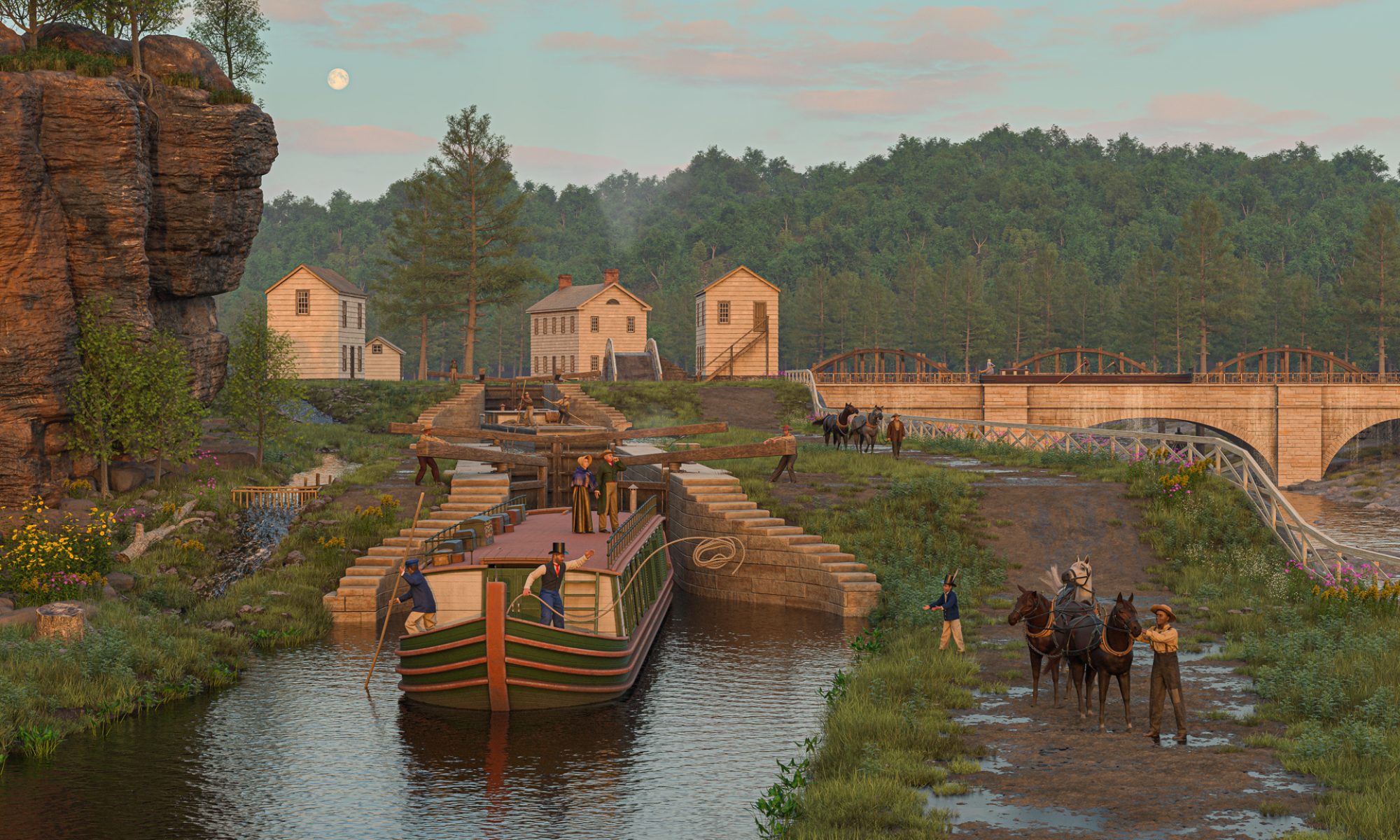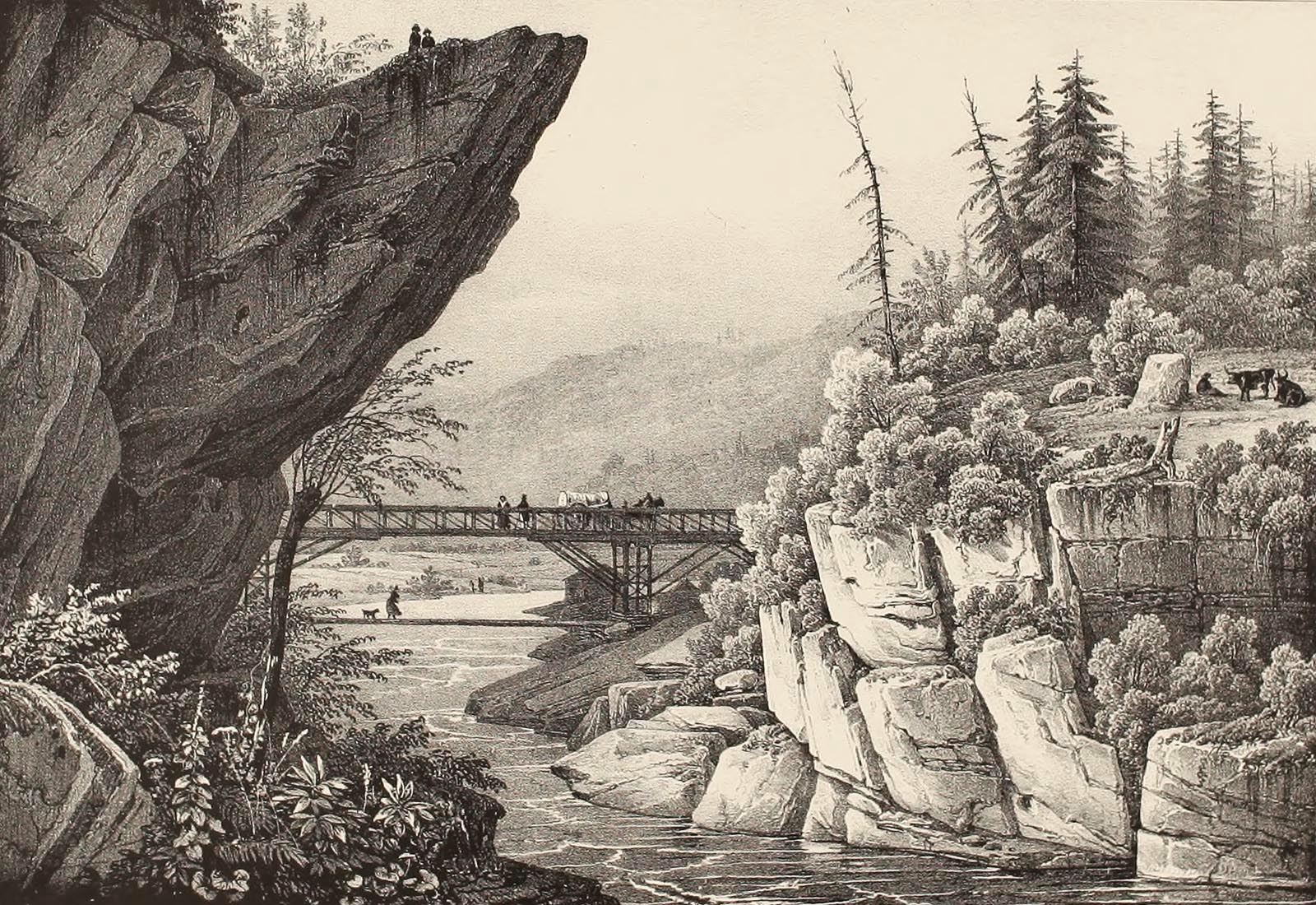
The early 19th century was an era of bridge building in the young United States.
White settlers were pushing their way across the Appalachians and the need for dependable overland transportation routes was becoming ever more urgent. Grain and raw materials needed to be sent to markets back east. Tools and other manufactured goods were ready to be shipped west.
State legislatures, wary of spending tax dollars on public infrastructure, instead encouraged private companies to build roads and bridges. In New York, dozens of companies were formed to build turnpikes for which they could charge tolls and, hopefully, turn a profit. Bridges would be needed to span the Hudson, Mohawk, Delaware, and myriad smaller streams and rivers that got in their way.
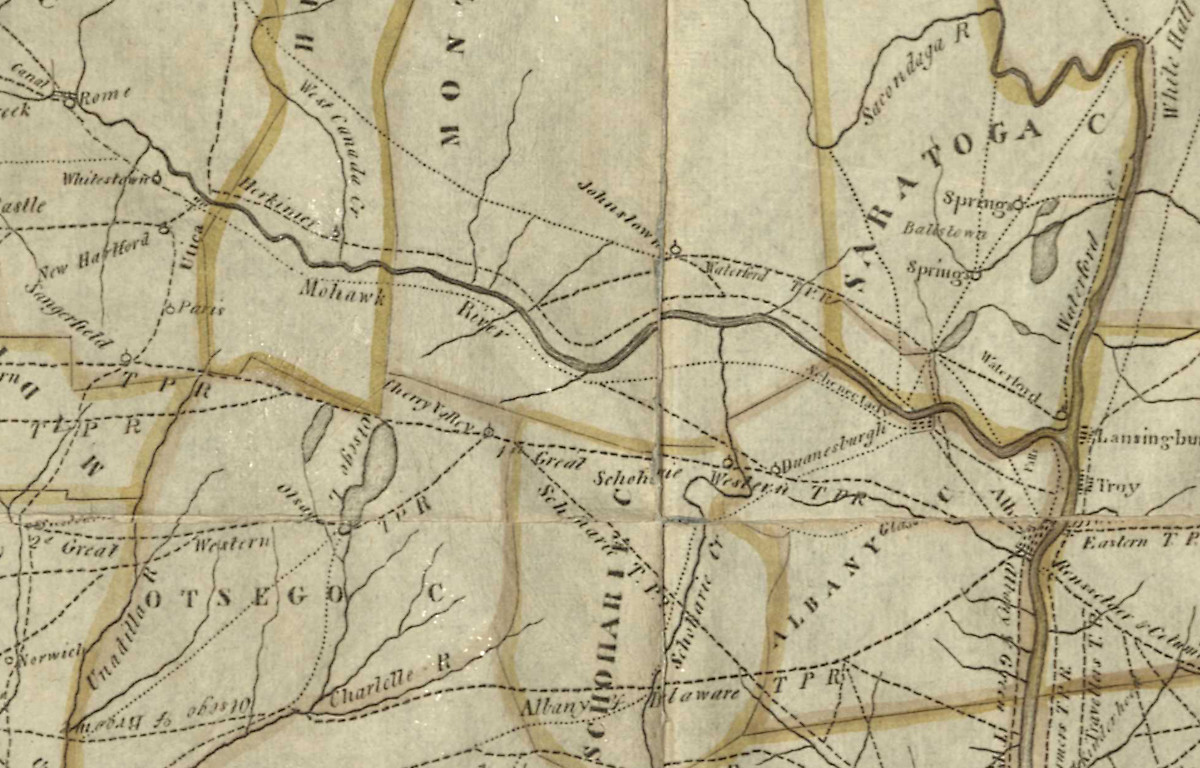
There were no professional engineers in those days, so mechanics, millwrights and carpenters stepped up to design and build those bridges. Their preferred construction material was timber, of which the forests provided an endless supply.
Their efforts were not scientific. Instead they relied on experience and common sense. In the long run, a handful of these carpenter-engineers would revolutionize bridge building and lay the foundations of American structural engineering.
The little community of Little Falls was there at the beginning.
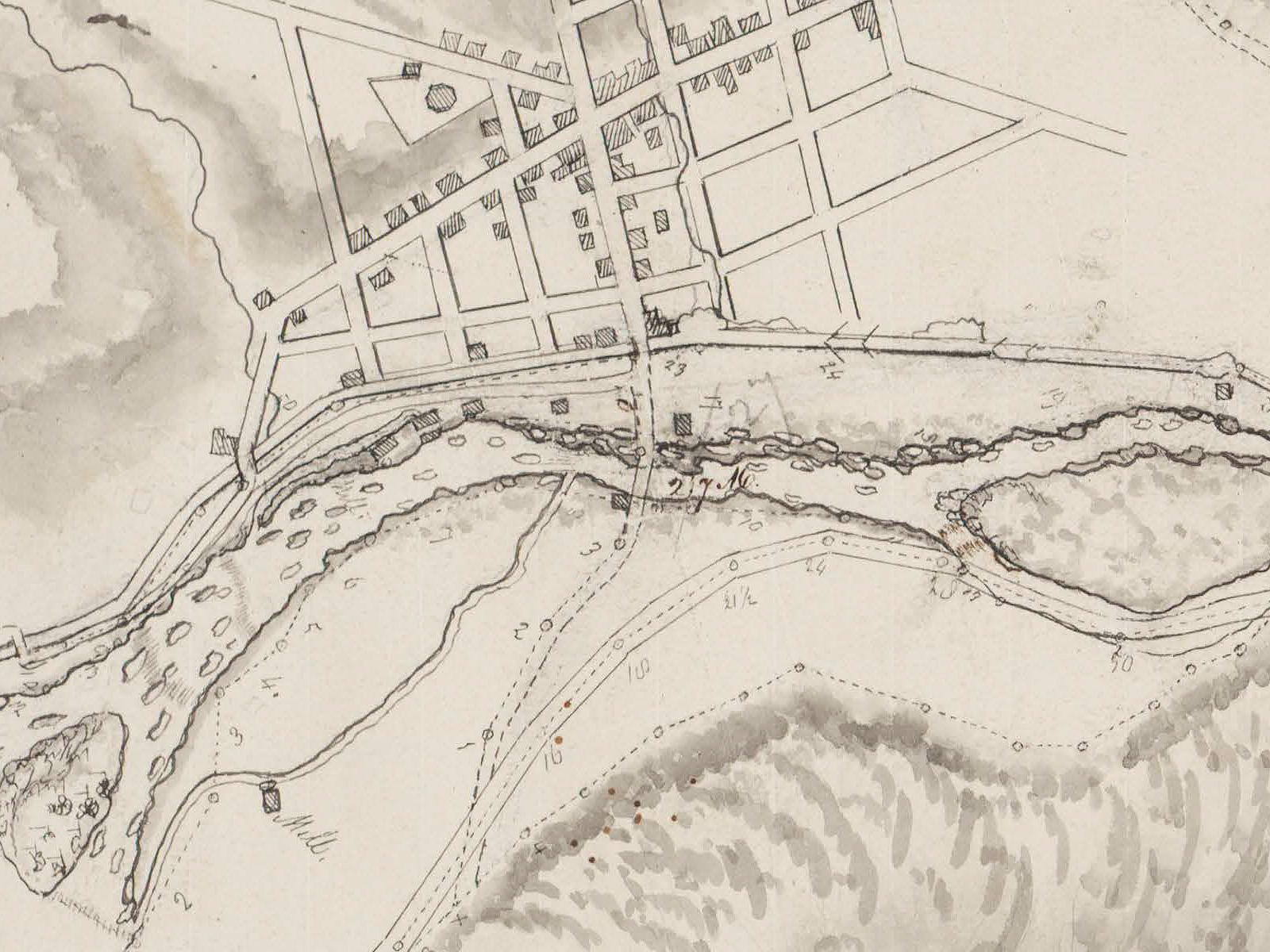
“A good and substantial bridge”
One of the first bridges across the Mohawk — perhaps the first — was thrown over the river at Little Falls in the early 1790s. The builder was John Beardslee, a Connecticut Yankee characterized by Nathaniel Soley Benton in A History of Herkimer County as a “practical mechanic, architect, and civil engineer.”
But Beardslee’s daring design, a single wooden arch that leapt over the rapids, became unsafe after only a few years. It would need to be replaced with something sturdier.
A group of leading citizens, including postmaster William Alexander and mill owner Christopher P. Bellinger, petitioned the state legislature to allow them to form the Fall Hill Turnpike and Bridge Company. The resulting incorporation act, passed April 9, 1804, charged the new company with two responsibilities: to build a short toll road along the foot of Fall Hill on the south bank of the Mohawk River, and to construct a new bridge.
The legislation instructed the company’s directors “to make a good and substantial bridge; and that said bridge shall be at least eighteen feet wide, with good and sufficient railings on each side of said bridge.” In the event that the bridge was “carried away by flood, or otherwise destroyed” — a regular occurrence in those days — “it shall be the duty of the said president, directors and company to rebuild the same within two years thereafter.”

The legislation went on to specify the rates of toll for the various kinds of traffic that might cross the bridge. Drovers would pay 8 cents for every score of sheep or hogs and 18 cents for every score of horses, cattle or mules. Carts drawn by one horse or mule would pay 6 cents. Rates were much higher for vehicles favored by the well-to-do: “every chariot, coach, coachee, or phaeton” would pay 25 cents.
Many users would be exempted from paying, including voters traveling to or from polling places, mourners attending funerals, patients visiting doctors, jurors, military troops, “any person going to or from any grist mill for the grinding of grain for his family use,” and so forth. In fact, the list of exceptions is so extensive that one wonders how the company was expected to make any money at all.
Tolls were also reduced for large wagons based on the width of their wheels. Those with wheels at least six inches wide would have their toll reduced by half; those with wheels at least nine inches wide, to one-fourth; and those with wheels at least twelve inches wide could pass “without paying any toll whatever.”
The Conestoga wagons used to haul freight on the turnpikes were enormous, 18 feet in length and 11 feet tall, and were drawn by teams of up to nine horses. One wagon could carry six tons of cargo. While the narrow wheels of smaller carts and carriages created ruts and damaged the track, the wide wheels of these heavy freight-carriers compacted and improved it. By reducing the fare for vehicles with wide wheels, the state and turnpike operators intended to improve the roadway as well as encourage trade.
Of course, any bridge built across the Mohawk would have to be sturdy enough to bear the weight of these huge, lumbering wagons. Good and substantial, indeed.
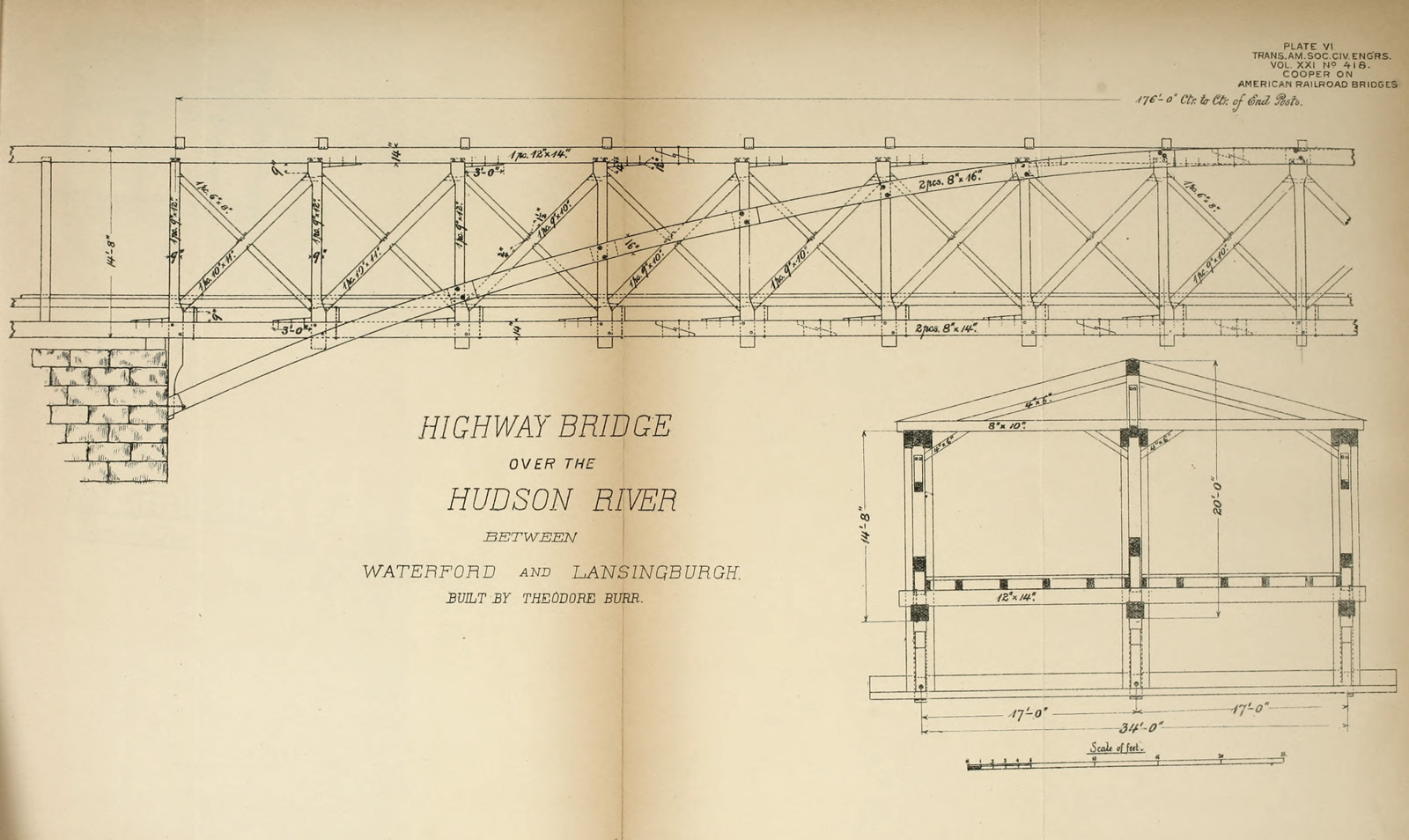
The mysterious Mr. Burr
The builder of the new toll bridge may have been Theodore Burr, one of the most celebrated bridge builders of the early 19th century.
This is according to Jeptha Root Simms, author of Frontiersmen of New York, published in 1882. Simms was writing many years later, and his information appears to be anecdotal. Still, if he is correct, the connection to Burr would be significant.
Theodore Burr was yet another Connecticut Yankee. Unlike his more famous (and notorious) cousin Aaron, Theodore apparently eschewed politics and instead moved to Oxford, New York, in the 1790s to establish a career as a millwright. He built a home and began raising a family with his wife, Asenath Cook. Eventually they would have seven children.
Over the course of his career, Burr would design and build more than 40 bridges, including major structures across the Mohawk, Hudson, Delaware, and Susquehanna rivers. But much of his life, including the details of his untimely death, is shrouded in mystery.

He began by constructing a bridge across the Chenango River at Oxford, followed by a 400-foot-long bridge across Catskill Creek in 1802. His ambition grew with experience. By 1806 he had finished at least two more bridges: one across the Mohawk River at Canajoharie, and another across the Delaware at Trenton, New Jersey.
The Trenton bridge would be heralded in America and Europe as a masterpiece. Anchored on four masonry piers, its five wooden arches carried a double carriageway 1,008 feet across the Delaware River. The arches were protected by a roof of cedar shingles but their sides were exposed to reduce wind load, a decision that allowed passers-by to admire the intricate interplay of struts and braces. With some modifications, this bridge would remain in service until 1875.
The fate of the Canajoharie bridge would be different. It was constructed as a single 330-foot arch, at the time the longest in North America or Europe. In a 2004 article in Structure magazine, F. E. Griggs describes what followed: “In 1807 . . . the bridge began leaning after a herd of cattle bunched up on one side of it. Burr attempted to correct this lean with supports near the abutments, but the bridge failed shortly thereafter.” The collapse reportedly could be heard for miles.
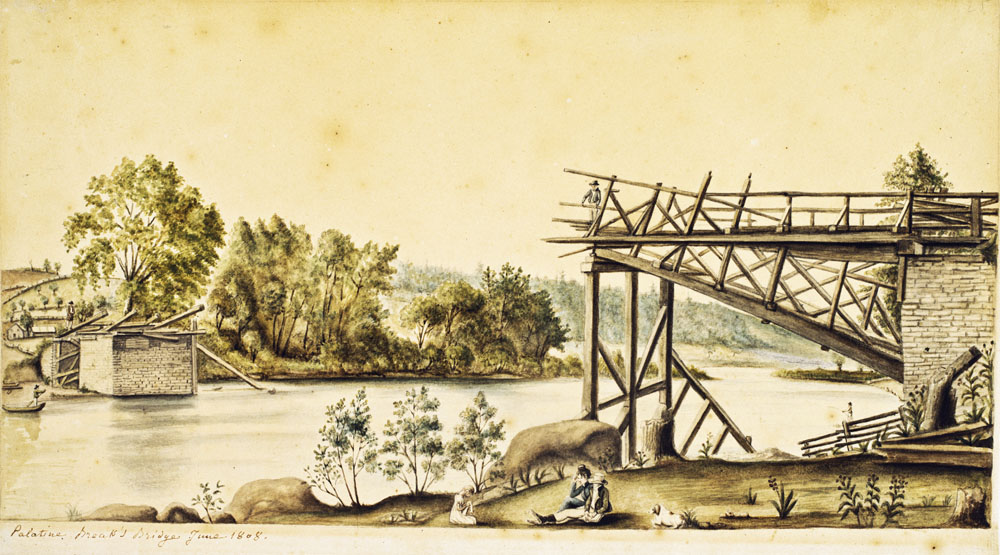
Burr’s later projects would include a 997-foot bridge over the Mohawk at Schenectady and a series of five bridges across the Susquehanna in Pennsylvania and Maryland.
His Schenectady bridge was a curiosity, a suspension bridge built of wood. In later years the elegant profile of the bridge’s wooden “cables” was obscured by an unsightly series of barn-shaped coverings. The roadway sagged and needed propping up with additional piers. Each spring, residents held their breath as they expected the flooding, ice-choked Mohawk to carry the bridge away. But it remained in service until 1873.
Unfortunately, Burr’s genius for design and experimentation was paired with a poorly developed business sense. He developed a habit of taking on too many projects at once. He was dogged by poor credit. Advance payments for one project were used to pay for others. He moved workers from nearly completed projects to those he deemed more pressing.
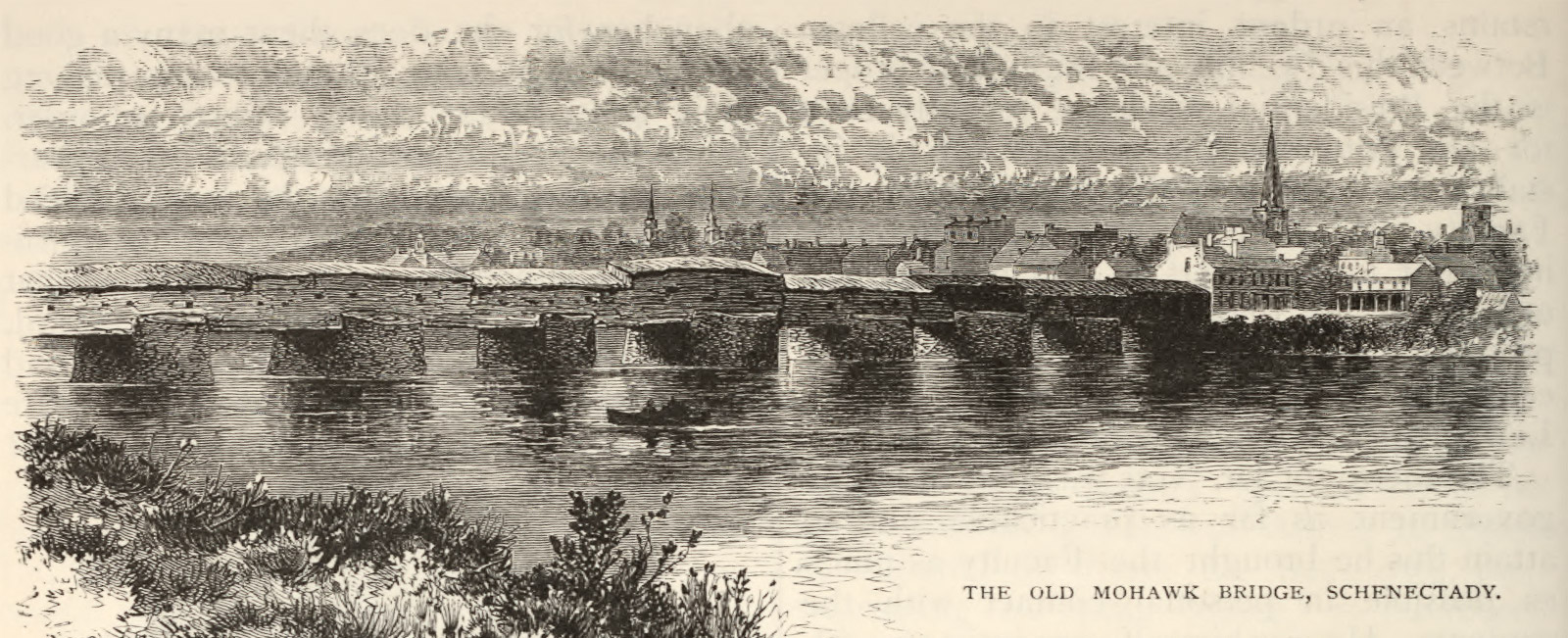
In 1822, the authors of a Pennsylvania legislative committee report complained that during construction of the Northumberland bridge “our bridge builder, Mr. Theodore Burr, having deserted the work, leaving our business to attend to contracts which he had subsequently made, we were under the necessity of finishing the work to save the bridge from perishing, by hiring hands ourselves.” They noted ruefully that “the managers never suspected that the man would have been so imprudent as to take on himself more work than he could attend to.” The company helped investors recover the extra cost by reclaiming $10,000 worth of company stock owned by Burr, which they had wisely retained as collateral.
Soon, none of this would matter to Theodore Burr. He had moved to Pennsylvania while working on his Susquehanna projects, and there, in November 1822, he died at the age of 51. The cause of his death was not recorded, nor was the location of his grave.
Today Burr is mostly remembered for his patented arch-truss, examples of which survive in historic covered bridges scattered across the northeast United States.

Reconstructing the toll bridge
Did Burr build the Little Falls bridge? We can’t say for certain. No definitive source — a letter, contract, or ledger — has yet to surface. During the period of the bridge’s construction between 1804 and 1807, Burr was involved with several other much larger projects. But as we have seen, he often worked on many things at once.
We do have one small piece of indirect evidence.
William Alexander, the Little Falls postmaster, was on the boards of both the Fall Hill Turnpike and Bridge Company and the Mohawk Turnpike and Bridge Company, which had been organized in 1800. This was the company for which Burr would build the bridge at Schenectady. Another board member was James Murdoch, a Schenectady merchant and sometime business partner and correspondent of Alexander.
Tucked among Alexander’s surviving letters is a single-page balance sheet listing expenses to be reimbursed to Murdoch by the company. The expenses include several cash payments made by Murdoch to “Theo. Burr” from late 1803 to early 1805.
Clearly, Alexander — who at times served as president of the Fall Hill Turnpike and Bridge Company — knew about Burr. They may have been personally acquainted. Could this have been the connection that led to a commission to build the Little Falls bridge?
Even if we could prove that Burr built the bridge, that would not necessarily tell us what it looked like. Throughout his career he experimented with many different forms. The two pieces of visual evidence that we have — the 1829–1830 Holmes Hutchinson survey map and the 1824 James Eights engraving — indicate that it comprised three spans resting on two piers anchored on the rocky bed of the Mohawk River, and that each span was supported by an arch.

The finished bridge model is based on these sources, as well as a few other contemporary engineering references. The 1838 edition of Dennis Hart Mahan’s An Elementary Course of Civil Engineering, for example, provides detailed instructions for building timber abutments and piers, and describes how those piers would be anchored in a shallow, swift-flowing river such as the Mohawk.
Much valuable information and advice was provided by Ronald Knapp and Terry Miller, whom I contacted via the Theodore Burr Covered Bridge Resource Center in Oxford, New York. They have done extensive research on Theodore Burr and his bridges, and I’d like to thank them for their insights on the bridge’s possible construction.
The bridge model will be added to the working scene, which is nearly finished. It will be placed directly behind the aqueduct and thus mostly hidden from the camera. About all that will be visible will be the top of the arches. A small detail, but one that provided yet another interesting detour on the way to Little Falls.
